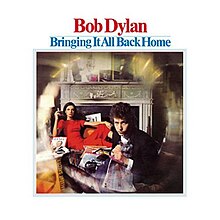| Bringing It All Back Home | ||||
|---|---|---|---|---|
 | ||||
| Studio album by | ||||
| Released | March 22, 1965 | |||
| Recorded | January 13–15, 1965 | |||
| Studio | Columbia 7th Ave, New York City | |||
| Genre | ||||
| Length | 47:21 | |||
| Label | Columbia | |||
| Producer | Tom Wilson | |||
| Bob Dylan chronology | ||||
| ||||
| Singles from Bringing It All Back Home | ||||
| ||||
Bringing It All Back Home (known as Subterranean Homesick Blues in some European countries; sometimes also spelled Bringin' It All Back Home[5]) is the fifth studio album by the American singer-songwriter Bob Dylan, released in March 1965 by Columbia Records.[6][nb 1] In a major transition from his earlier sound, it was Dylan's first album to incorporate electric instrumentation, which caused controversy and divided many in the contemporary folk scene.[7]
The album is split into two distinct halves; the first half of the album features electric instrumentation, in which on side one of the original LP, Dylan is backed by an electric rock and roll band. The second half features mainly acoustic songs. The album abandons the protest music of Dylan's previous records in favor of more surreal, complex lyrics.[8]
The album reached No. 6 on Billboard's Pop Albums chart, the first of Dylan's LPs to break into the US Top 10. It also topped the UK charts later that spring. The first track, "Subterranean Homesick Blues", became Dylan's first single to chart in the US, peaking at No. 39. Bringing It All Back Home has been described as one of the greatest albums of all time by multiple publications.[9][10][11][12] In 2003, it was ranked number 31 on Rolling Stone's list of the "500 Greatest Albums of All Time", later repositioned to number 181 in the 2020 edition.
- ^ Hermes, Will (March 22, 2016). "How Bob Dylan's 'Bringing It All Back Home' 'Stunned the World'". Rolling Stone. Archived from the original on May 29, 2016. Retrieved June 4, 2016.
We look back at Bob Dylan's 'Bringing It All Back Home,' which saw him go electric, invent folk rock and redefine what can be said in a song.
- ^ Breihan, Tom (September 21, 2010). "Morning Benders, Mirah Pay Bob Dylan Tribute". Pitchfork.
- ^ Cite error: The named reference
AMwas invoked but never defined (see the help page). - ^ June Skinner Sawyers (May 1, 2011). Bob Dylan: New York. Roaring Forties Press. p. 77. ISBN 978-0-9846254-4-4.
- ^
- Sablich, Justin (October 18, 2016). "Bob Dylan's New York: A Playlist". New York Times. Retrieved September 27, 2022.
- Strauss, Valerie (October 14, 2016). "Teaching Dylan: "His work as a whole is as staggering as that of Homer or Shakespeare"". Washington Post. Retrieved September 27, 2022.
- Harvilla, Rob (January 27, 2011). "Dylan's Voice Archive: Nobody Likes Him in His Hometown". The Village Voice. Retrieved September 27, 2022.
- ^ Cash Box, April 10, 1965, page 6
- ^ Irwin Silber, editor of folk magazine Sing Out! described Dylan's new music as "a freak and a parody". Bob Dylan by Anthony Scaduto, Abacus Books, 1972, p. 188
- ^ Woodward, Richard B. (March 18, 2015). "Dylan's Double Personality: Celebrating the 50th Anniversary of 'Bringing It All Back Home'". Wsj.com. Retrieved July 21, 2019.
- ^ "Bob Dylan's triumphant album 'Bringing It All Back Home'". faroutmagazine.co.uk. March 22, 2021. Retrieved November 6, 2022.
- ^ Hermes, Will (March 22, 2016). "How Dylan's 'Bringing It All Back Home' 'Stunned the World'". Rolling Stone. Retrieved November 6, 2022.
- ^ "500 Greatest Albums of All Time". Rolling Stone. May 31, 2009. Retrieved November 6, 2022.
- ^ "Revisiting Bob Dylan's 'Bringing It All Back Home' (1965) | Retrospective Tribute". Albumism. Retrieved November 6, 2022.
Cite error: There are <ref group=nb> tags on this page, but the references will not show without a {{reflist|group=nb}} template (see the help page).